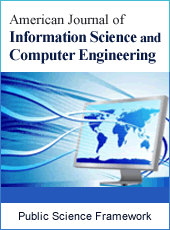American Journal of Information Science and Computer Engineering
Articles Information
American Journal of Information Science and Computer Engineering, Vol.2, No.5, Sep. 2016, Pub. Date: Oct. 5, 2016
Fault Prediction Method Combining Principal Component Analysis and Back Propagation Neural Network
Pages: 63-69 Views: 4236 Downloads: 833
[01]
Kaixuan Wang, School of Information Engineering, China University of Geosciences, Beijing, China.
[02]
Mei Li, School of Information Engineering, China University of Geosciences, Beijing, China.
[03]
Wanxin Shi, School of Information Engineering, China University of Geosciences, Beijing, China.
[04]
Xu Liu, School of Information Engineering, China University of Geosciences, Beijing, China.
[05]
Shiyao Qin, New Energy Institute, China Electric Power Research Institute, Beijing, China.
[06]
Xiaojing Ma, New Energy Institute, China Electric Power Research Institute, Beijing, China.
Fault prediction of wind turbine could greatly reduce its operation and maintenance cost. A fault prediction method combining Principal Component Analysis (PCA) and Back Propagation Neural Network (BPNN) is proposed. Using only BPNN to predict the turbine fault, one has to pick out proper attributes for training and that can be a troublesome work. With PCA revealing the hidden relationship between attributes, we no longer need to select attributes by experience thus saving cost. Also, PCA largely reduce the dimension of attributes so that the curse of dimensionality can be avoided. The proposed PCA-BPNN method can improve the accuracy by 3% compared BPNN method, so that abnormal state of the mechanical faults can be determined more precisely, again reduce the maintenance cost.
Fault Prediction, Data Mining, Principal Component Analysis, Back Propagation Neural Network, Wind Turbine
[01]
Azevedo D; Machado H D; Araújo, et al. A review of wind turbine bearing condition monitoring: State of the art and challenges. RSER, 2016, 56: 368-379.
[02]
Aziz, M. A.; Noura, H., & Fardoun, A. General review of fault diagnostic in wind turbines. 18th Mediterranean Conf. on Con. & Aut., 2010, MED’10, pp. 1302 - 1307 doi: 10.1109/med.2010.5547870.
[03]
Amirat Y, Benbouzid MEH, Al-Ahmar E, Bensaker B and Turri S. A brief status on condition monitoring and fault diagnosis in wind energy conversion systems. RSER, 2009, 13, pp. 2629-36.
[04]
Schlechtingen M, Santos IF and Achiche S. Wind turbine condition monitoring based on SCADA data using normal behavior models. Part 1: System description. App. Soft Com. 2013, vol. 14, pp. 447–460.
[05]
Aloraini, A., & Sayed-Mouchaweh, M. Graphical Model Based Approach for Fault Diagnosis of Wind Turbines. International Conference on Machine Learning and Applications, 2014, pp. 614 - 619.
[06]
Santos P; Villa LF; Reñones A; Bustillo A and Maudes J. An SVM-Based Solution for Fault Detection in Wind Turbines. Sensors, 2015, vol. 15, 5627-48.
[07]
Odofin S, Gao Z and Sun K. Robust fault estimation in wind turbine systems using GA optimisation. Industrial Informatics (INDIN), 2015 IEEE 13th International Conference on. IEEE, 2015, pp. 580-5.
[08]
Lan Q; Zhao PD; Wang ML. Fault Diagnosis of Wind Turbines Based on Improved Neural Network. Advanced Materials Research, Trans Tech Publ, 2014, pp. 78-83.
[09]
Malik H; Mishra S. Application of Probabilistic Neural Network in Fault Diagnosis of Wind Turbine Using FAST, TurbSim and Simulink. Procedia Computer Science. 2015; vol. 58, pp. 186-93.
[10]
Xu Liu, Mei Li et al, A Predictive Fault Diagnose Method of Wind Turbine Based on K-means Clustering and Neural Networks. JIT, 2016, vol. 17 (online), doi: 10.6138/JIT.2016.17.7.20151027i.
[11]
Jolliffe I. Principal component analysis. Wiley Online Library, 2002.
[12]
Mcmurtrey SD. Training and optimizing distributed neural networks using a genetic algorithm. Nova Southeastern University, 2010.

ISSN Print: 2381-7488
ISSN Online: 2381-7496
Current Issue:
Vol. 7, Issue 3, September Submit a Manuscript Join Editorial Board Join Reviewer Team
ISSN Online: 2381-7496
Current Issue:
Vol. 7, Issue 3, September Submit a Manuscript Join Editorial Board Join Reviewer Team
| About This Journal |
| All Issues |
| Open Access |
| Indexing |
| Payment Information |
| Author Guidelines |
| Review Process |
| Publication Ethics |
| Editorial Board |
| Peer Reviewers |


